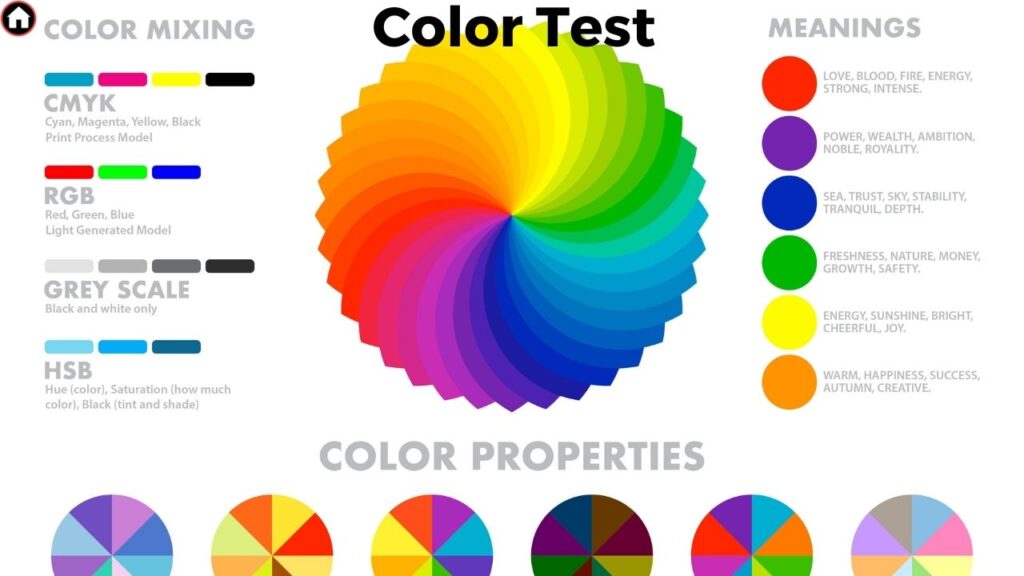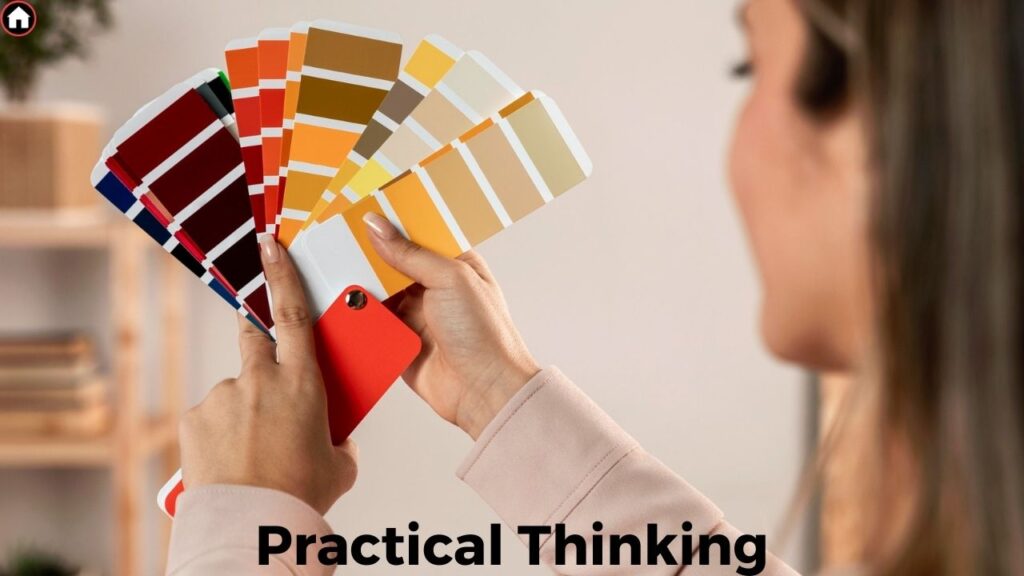Choosing the right color palette for your home can be a daunting task, but it doesn’t have to be. In this informal and informative guide, we’ll take you through each step of the process, ensuring that you’ll not only get a beautiful color scheme but also a color that perfectly suits your space and style. yes. Let’s delve deeper and learn how to choose the right color palette for your home.
I. Psychology of Colors

Colors have a profound impact on our daily lives, influencing our emotions and behavior. Understanding how to choose the right color palette for your home starts with understanding the psychology of colors. Each color holds its unique energy and meaning. Warm colors like vibrant reds and vibrant oranges can fill a space with energy and vitality. Meanwhile, cool tones like cool blue and cool green create a feeling of peace and relaxation. To get the most out of your home’s ambiance, consider the emotional associations of colors and think about how to choose the right color palette for your home that matches your desired ambiance.
II. Assessing Your Location
Before you embark on the exciting journey of choosing the perfect color palette for your home, take some time to truly understand your living space. This step is important to ensure that the colors you choose not only look beautiful but also match the unique features of each room.
Natural light and your space: Start by assessing the amount of natural light each room receives. Rooms bathed in abundant sunlight can handle darker and warmer colors, while spaces with limited natural light may benefit from lighter and cooler colors. Consider which direction the room faces; North-facing rooms have cool, blue light, while south-facing rooms have warm, yellow light.
Size and Layout Considerations: Size matters when it comes to color. In small rooms, light shades can create the illusion of space and make them feel more open. Conversely, larger rooms can adopt darker colors to create a comfortable and inviting ambiance. Also, think about the layout of each room. How you arrange furniture and décor can affect how colors are perceived.
Existing Furniture and Décor: Take stock of your existing furniture, décor, and fixtures. Are there any pieces you love that you want to incorporate into your color palette? Consider the colors of these items and how they will fit into your overall scheme. If you have neutral furniture, you have more flexibility with your color choices, but bold existing pieces may require more thoughtful color coordination.
You may also like: 10 Simple Velvet Home Décor Ideas
III. Finding Inspiration

Feeling inspired is essential when it comes to choosing the right color palette for your home. Inspiration can come from a variety of sources, and the more you collect, the clearer your vision will be.
Color Trends: Stay up to date with current color trends in interior design. Magazines, websites, and social media platforms often showcase the latest color palettes that are in vogue. These trends may introduce new and innovative ideas that you may not have considered.
Exploring Design Magazines: Home design magazines are a treasure trove of inspiration. Flip through their pages or browse their websites to find real-world examples of how color is used effectively in a variety of home settings. Pay attention to how different palettes create unique environments.
Online Platforms: Platforms like Pinterest and Instagram are virtual wonderlands for interior design enthusiasts. Create a collection of boards or images that catch your attention. You’ll find tons of curated home design photos that can spark your creativity. These platforms often link to articles and DIY projects that can further inform your decisions.
You may also like: How to Improve Home Lighting For Living Room
IV. Creating a Mood Board
A mood board is your creative canvas where you can visually experiment with colors, patterns, and textures. This serves as a solid reference that keeps you on track during the color selection process.
Collect color swatches and swatches:
Start by collecting paint swatches, fabric swatches, and any materials you want to use in your space. These could be upholstery fabrics, curtains, or even photos of inspirational places. Put them on your mood board to see how they interact.
Combining Colors Effectively:
Experiment with different color combinations on your mood board. Arrange samples and samples to create potential palettes. Pay attention to how these colors work together and create different moods. Don’t hesitate to move things around until you find a combination that suits you.
Adding Texture and Pattern:
Colors are just one element of design. Consider the textures and patterns you want to introduce into your space. Including these elements on your mood board can help you envision the overall look and feel of your room. This is a chance to create a rich and layered aesthetic.
You may also like: 10 Creative Home Office Ideas For Small Spaces
V. Color Test

Don’t skip this step; This is a game-changer. Buy paint samples or use peel-and-stick samples to test your chosen colors in a real space. See how colors look in different lighting conditions and at different times of the day. This practical approach will prevent any unpleasant surprises once you start painting.
VI. Color Harmonies and Schemes
Now that you’ve collected some favorite colors, let’s talk about harmonious combinations. Explore different color schemes like monochromatic, analogous, complementary, and triadic. Each plan offers a unique visual appeal and can set the tone for your entire home. Consider the balance of colors in each room to achieve the desired atmosphere.
VII. Accent Colors and Statement Pieces
A well-thought-out color palette often includes accent colors and statement pieces. These components can give your area depth and character. Choose colors for attractive walls, trim, or furniture that create visual interest without overwhelming the room. Don’t be afraid to incorporate bold and unique pieces that reflect your style and tastes.
You may also like: Cheap and Easy Home Décor Ideas For Home
VIII. Practical Thinking

While aesthetics matter, functionality is equally important. Think about the maintenance and cleaning requirements of your chosen colors. Some colors are more forgiving when it comes to dirt and wear. Additionally, consider the resale value of your color choices and their long-term suitability for your space.
IX. Adaptation to Different Rooms
Each room in your home serves a different purpose, and the right color palette can enhance its function. The process of how to choose the right color palette for your home isn’t limited to choosing a few samples; This extends to tailoring your choices to the unique character and role of each room.
For example, living rooms often serve as gathering places for family and friends, so warm and inviting palettes work wonderfully here. In contrast, bedrooms should provide soothing relaxation, making soft and calming colors the ideal choice. Kitchen and dining areas can be versatile.
You can choose playful or elegant depending on your preference. Bathrooms, on the other hand, can benefit from a balance of tranquility and style, creating a spa-like atmosphere. Choosing the right color palette for your home means taking into account the specific needs and personality of each room.
X. DIY vs. Hiring a Professional

Deciding whether to do the painting yourself or hire a professional is an important decision. Evaluate the pros and cons, taking into account your time, skill level, and complexity of the project. In some cases, consulting an interior designer can provide valuable insight and ensure an impeccable outcome.
XI. Gathering Supplies
Before you begin your painting journey, gather all the necessary supplies. You will need paint, brushes, rollers, painter’s tape, and drop cloth. Remember to wear safety equipment like goggles and a mask.
Proper preparation and having the right tools on hand will make the painting process easier.
XII. Painting Process

Now, let’s get to the fun part – the actual painting. Prepare the room by removing furniture and covering surfaces with cloth. Apply primer to create a smooth canvas for your chosen colors. When it’s time to paint, use a steady hand and consider different techniques for different areas. A proactive approach ensures professional completion.
XIII. Final Touches and Decorations
Once the paint is dry, it’s time for final touches and decoration. Add decorative elements like artwork, throw pillows, and rugs that complement your color palette. Arrange furniture strategically to make the most of your newly transformed space. Pay attention to lighting, as it can greatly affect the way colors appear.
You may also like: 10 Stylish Storage Solutions For Living Room
XIV. Maintaining Your Color Palette
Congratulations on finding the perfect color palette for your home! To keep it looking fresh and vibrant, establish a maintenance routine. Regular cleaning and periodic touch-ups will help maintain the beauty of your space. Over time, consider updating elements like décor and accessories to keep pace with changing color trends.
XV. Conclusion: Your Colorful Home Journey
Ultimately, embarking on the journey of how to choose the right color palette for your home is a creative adventure that leads to a space uniquely yours. Armed with insight into the psychology of color, a thorough assessment of your living environment, and an abundance of inspiration, you can confidently create a harmonious and attractive haven. Keep in mind that your home is a canvas to express your personality and style, so embrace the process and enjoy every moment of choosing the right color palette for your home. May your living space be a reflection of your unique taste, and may it continue to evolve and inspire you.
XVI. FAQ: How to Choose The Right Color Palette For Your Home.
1. How do I choose a color palette for my home?
Answer:- Choosing a color palette for your home can be an exciting but challenging endeavor. Follow these steps to make the process easier:
Evaluate your space: Start by evaluating your space. Consider the size, layout, and natural lighting of each room. Understanding these factors will help you determine which colors will work best.
Define the mood: Think about the mood or atmosphere you want to create in each room. Do you want a cozy, comfortable atmosphere in the living room, or a vibrant and energetic feel in the kitchen? Define the emotions you want to evoke.
Gather Inspiration: Take inspiration from a variety of sources. Look at interior design magazines, browse websites, and create mood boards with color swatches, fabric swatches, and images that suit you. This will help you narrow down your preferences.
Consider existing elements: Take into account any existing furniture, décor, or fixtures that you plan to keep. Make sure your chosen color palette matches these elements.
Test paint samples: Don’t skip the step of testing paint samples on your walls. Paint a small area and see how it looks in different lighting conditions throughout the day.
Think about color harmony: Explore different color harmonies, such as monochromatic, analogous, complementary and triadic schemes. Harmonious combinations can create a harmonious and visually pleasing look.
Customize for each room: Remember that different rooms may require different color palettes depending on their function and the mood you want to establish. Prepare your choice accordingly.
Start with neutrals: If you’re unsure, consider starting with neutral colors as a base and then add pops of color with décor and accessories. Neutrals offer versatility and can be easily updated.
Get feedback: Don’t hesitate to seek feedback from friends, family or even professional interior designers. Sometimes an outside perspective can provide valuable insight.
Trust your instincts: Ultimately, trust your instincts and choose colors that suit you. Your home should reflect your personal style and make you feel comfortable and happy.
Q2. What is the 60-30-10 color rule?
Answer:- The 60-30-10 color rule is a fundamental principle in interior design that provides a straightforward guideline for creating a balanced and visually appealing color scheme in a room. This rule suggests allocating percentages of three different colors as follows:
60% Dominant color: This should be the primary color used in the room and usually covers the largest area. This sets the foundation for the color scheme and creates a harmonious background. Often, it is applied to walls, large pieces of furniture, or floors.
30% Secondary Color: The secondary color complements the dominant color and adds depth and visual interest. It is commonly applied to items such as upholstered furniture, curtains, or decorative walls. This color should harmonize with the dominant color while providing contrast.
10% accent color: Accent color is the smallest percentage, but plays an important role in adding vibrancy and personality to the room. It is used for accessories, pillows, artwork or decorative accents. This color should create visual accents and draw attention to specific areas.
Q3. Can I use multiple color palettes in one home?
Answer:- Absolutely! Mixing palettes can create interesting contrasts and define different areas of your home.
Q4. How can I make a small room look bigger with paint?
Answer:- Choose light colors and use mirrors to create the illusion of space.
Q5. What is the best color for a home office to increase productivity?
Consider shades of blue or green for a calm and centered environment.
Q6. Is it okay to follow color trends or should I stick to classic colors?
Answer:- Trends can be fun, but classic colors like neutral tones are timeless and versatile.
Q7. How often should I repaint my house to keep it looking fresh?
Answer:- This depends on factors like wear and tear, but a new coat of paint every 5-10 years is a good rule of thumb.
Q8. Can I change my color palette in a rented apartment?
Answer:- Most landlords allow painting with approval, but if not allowed consider the peel-and-stick option.
Q9. What colors work best for a cozy bedroom atmosphere?
Answer:- Cool blues, light grays, and soothing lavenders are excellent choices for a tranquil bedroom.
Q10. Should I match my furniture to my color palette?
Answer:- Coordinating furniture with your palette can create a cohesive look, but mixing styles can also be stylish and unique.


[…] You may also like: How to Choose the Right Color Palette For Your Home […]